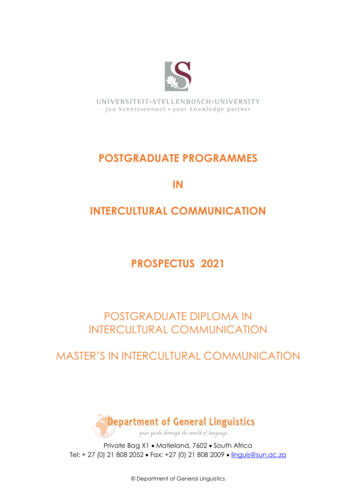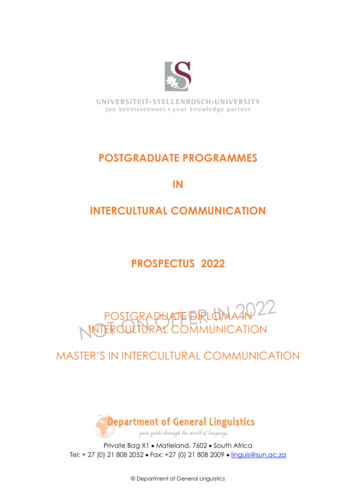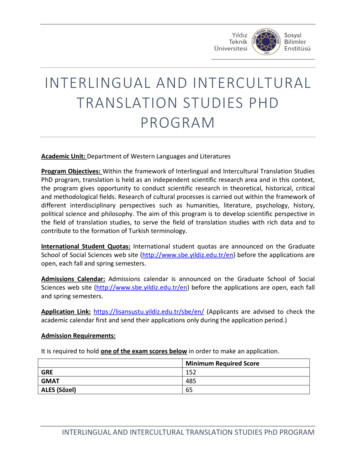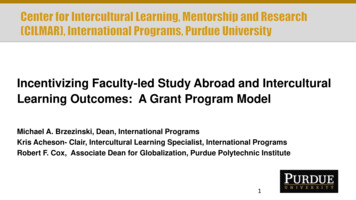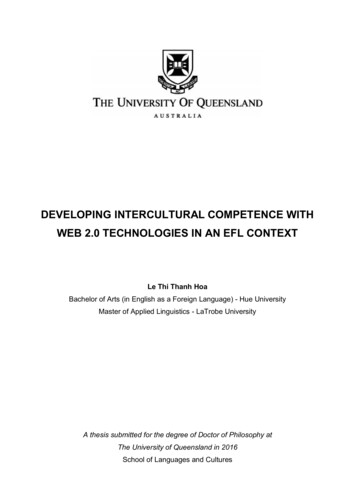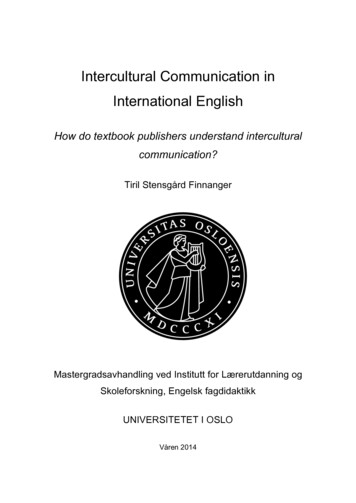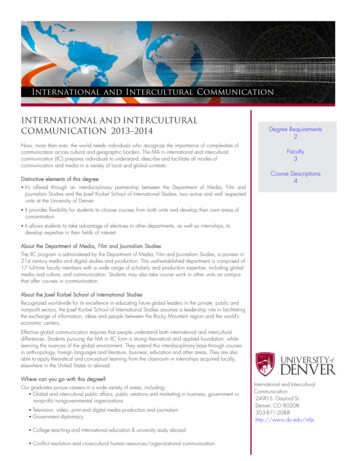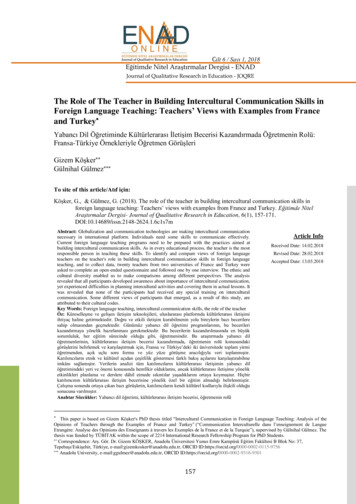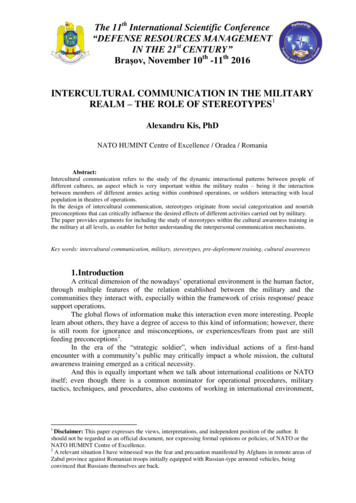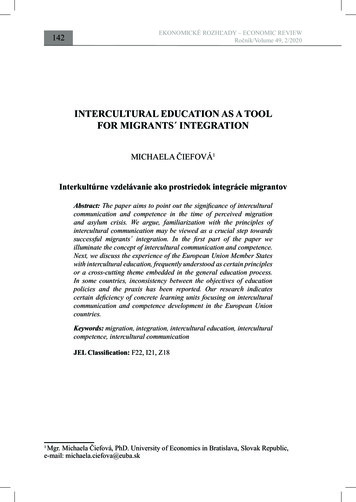
Transcription
142EKONOMICKÉ ROZHĽADY – ECONOMIC REVIEWRočník/Volume 49, 2/2020INTERCULTURAL EDUCATION AS A TOOLFOR MIGRANTS INTEGRATIONMICHAELA ČIEFOVÁ1Interkultúrne vzdelávanie ako prostriedok integrácie migrantovAbstract: The paper aims to point out the significance of interculturalcommunication and competence in the time of perceived migrationand asylum crisis. We argue, familiarization with the principles ofintercultural communication may be viewed as a crucial step towardssuccessful migrants integration. In the first part of the paper weilluminate the concept of intercultural communication and competence.Next, we discuss the experience of the European Union Member Stateswith intercultural education, frequently understood as certain principlesor a cross-cutting theme embedded in the general education process.In some countries, inconsistency between the objectives of educationpolicies and the praxis has been reported. Our research indicatescertain deficiency of concrete learning units focusing on interculturalcommunication and competence development in the European Unioncountries.Keywords: migration, integration, intercultural education, interculturalcompetence, intercultural communicationJEL Classification: F22, I21, Z18Mgr. Michaela Čiefová, PhD. University of Economics in Bratislava, Slovak Republic,e-mail: michaela.ciefova@euba.sk1
EKONOMICKÉ ROZHĽADY – ECONOMIC REVIEWRočník/Volume 49, 2/20201431 IntroductionAs a consequence of globalisation, the contact with people with different cultural backgrounds has become an everyday reality (Kumbier and Schulz vonThun, 2016). Migration influences “the rhythm and the tempo of the contemporary modern society” (Kuo, 2014, p. 16). The tendency to migrate mayconsiderably impact culture and the structure of the society, as the elementsof the host culture and the culture of immigrants collide. Such interculturalencounters can happen without complications, or, on the contrary, can induceoccurrence of intercultural problems or conflicts (Štefančík and Lenč, 2012).These situations can be avoided or at least mitigated, but that requires a certain mental framework of the participants of the intercultural encounter. Themental framework – or intercultural competence – is no inherent trait of anindividual; normally, it takes certain time and effort to properly develop it. Asa matter of fact, people are not always aware that their attitude and a way ofcommunication should be tailored to the communication partner.Intercultural communication and intercultural competence have been receiving attention of the academic community for a while now; they are no newtopics in scholarly work, and neither is the need for intercultural competencein Europe. Hoskins and Sallah (2011), for instance, stress the prominence ofintercultural competence and dialogue in Europe already in their paper from2011. Even in 1994, Campani and Gundara (1994) recognized the need toinitiate dialogue on intercultural education between Northern and SouthernEuropean countries, the need for which was intensified by ongoing economic,political and social changes. Furthermore, policy makers have started to realise the impact intercultural communication may have on integration processes.Intercultural communication sometimes serves as a kind of tutorial for migration governance and management. In Italy, for example, the migration governance process was based on principles of intercultural communication, asdiscussed by Del Percio (2016). The concept of intercultural mediation linkedto migration is utilised by Diaz (2018).Migration as an interdisciplinary phenomenon is currently studied from different perspectives (Čiefová and Raneta, 2018a). Due to the changing migrationpatterns and new forms of migration, the overall concept has been repeatedlychallenged (Faas, Hajisoterioub and Angelides, 2014). Contemporary academic and political discourse understands migration as the arrival to alreadyfounded sovereign nation states (Némethová, 2018). Obviously, also the term
144EKONOMICKÉ ROZHĽADY – ECONOMIC REVIEWRočník/Volume 49, 2/2020migrant is used in various contexts and hence vague. This is crucial mainlywhen analysing the consequences of migration (Stradiotová, 2019). To avoidconfusion, we are particularly interested in the period of the perceived migration crisis in Europe, i.e. the year 2014 onwards. Hence, when referring tomigrants, we mean mostly individuals who entered Europe during the recentyears. Nevertheless, the ideas presented herewith may be applied to migrationprocesses in general.The primary objective of our study is to point out the significance of intercultural communication and competence in the era of perceived migration crisis.Additionally, we attempt to provide an overview of how intercultural education is (or is not) reflected in learning curricula of selected European countries, and to propose measures how to improve the current state. Accordingly,the paper is divided into two interrelated sections. In the first part we outlinethe definitions of the concept of intercultural communication and intercultural competence as a specific set of skills required in the era of migrationand globalisation. In the second part, we describe and assess the experienceof selected European Union Member States with the implementation of intercultural education as a prerequisite of migrants integration, with specialattention being paid to Slovakia. In order to facilitate integration, both sides ofthe process should be equally involved, i.e. the host community as well as theincoming individuals or groups.The research presented herewith is mostly of qualitative nature. We apply themethod of analysis, mainly policy analysis, and synthesis based on an extensive literature review. The collection of a significant amount of qualitative dataconcerning the studied phenomena allowed us to assess the ongoing policiesand propose feasible recommendations.2 Intercultural Communication and Competence RevisitedIntercultural communication is examined for instance in relation to languageacquisition, international trade, or cross-border cooperation. Those involvedin intercultural dialogue should realise the mutual benefit it can bring (Helmová, 2018). However, this is not always the reality.Průcha (2010) approaches the concept of intercultural communication in athreefold manner. According to him, intercultural communication is:
EKONOMICKÉ ROZHĽADY – ECONOMIC REVIEWRočník/Volume 49, 2/2020145a) a process of exchange of verbal and nonverbal contents;b) research and scientific disciplines;c) educational and support activities focusing on practical applications.Concerning the nomenclature, all three denotates carry the same name. Therefore, it is necessary to always specify the context in which the notion isutilised (Průcha, 2010).In scientific literature, we even encounter the principles of intercultural communication being compared to IT processes. In this case, intercultural communication is thought to be a sort of software interface, allowing two distinctoperational systems – cultures - to collaborate (Čiefová and Raneta, 2018b).Nevertheless, it needs to be remembered that intercultural communication happens in a context, meaning the communication process and its success is notdependent exclusively on the participants, but on many more other factors,such as the political or economic situation (of the country or of the individual)(Keding, 2016).Indeed, there have been many attempts to properly define the term intercultural communication, and some researchers were ambitious as to summarizethe available definitions (e.g. Čiefová and Raneta, 2018b). The reason for existence of numerous definitions might be the obvious interdisciplinarity of theconcept.2.1 Intercultural Competence and Its ConstituentsIntercultural competence can be simply defined as the ability of an individualto communicate effectively with representatives of distinct cultures. The individual needs to utilise knowledge of national cultures. Besides, respect forcultural differences is a crucial prerequisite (Průcha, 2010).Several models of intercultural competence have been developed by scholars so far. Matveev (2017) summarizes intercultural competence models asfollows: compositional, relational, behavioural, developmental, causal andcollaborative. For the purpose of this article we have decided to refer to oneof the compositional models to characterise the construct. Compositional models summarize traits and skills enabling smooth intercultural communication (Matveev, 2017), as they consist of various elements creating the overallconcept of intercultural competence (Jeleňová, 2017). Due to their structure,
146EKONOMICKÉ ROZHĽADY – ECONOMIC REVIEWRočník/Volume 49, 2/2020we consider compositional models of intercultural communication to be botheloquent and comprehensible.One of the most frequently cited models of intercultural competence is the oneshown in Figure 1 below. According to this model, intercultural competenceis composed of three equally important dimensions, namely cognitive competence, behavioural competence and affective competence. In addition, eachone of these further incorporates several components.The cognitive component of intercultural competence includes mainly theknowledge of an individual. It refers to the need for collecting relevant information about a country and its culture, whereby this mainly concerns businessmen, politicians, diplomats, or students. One of the abilities falling underthis category is self-reflection. Affective competence represents primarily theattitude of a communicant towards representatives of distinct cultures, whichinvolves for instance the ability to tolerate ambiguity (Ambiguitätstoleranz)(Erll and Gymnich, 2008), adaptability and people orientation. Another crucial element of affective competence is (cultural) empathy as a part of humanemotional intelligence. To foster empathy is one of the main objectives of intercultural training (Morgensternová and Šulová, 2007). Behavioural competence entails applications of adequate and appropriate communication patterns(Erll and Gymnich, 2008).Figure 1: Components of intercultural competenceSource: Author s own elaboration based on Morgensternová, Šulová et al. (2007, p. 10).
EKONOMICKÉ ROZHĽADY – ECONOMIC REVIEWRočník/Volume 49, 2/2020147Some authors use the term of cultural intelligence, as being “modestly related to but distinct from emotional intelligence and personality and correlatespositively with several indicators of multicultural experience,” and relating tointercultural effectiveness (Thomas et al., 2015). Indeed, empirical experienceof an individual may significantly impact their attitudes towards migrants, andthus the level of intercultural competence.As Puškárová and Dancáková (2018) point out, previous experience with working abroad seems to affect one s attitude towards migrants much more thanbeing exposed to them at home.One should distinguish between intercultural competence and interculturalcommunication competence. The former stands for skills needed to be competent regarding cultural issues; the latter primarily refers to skills demonstratedin intercultural communication situations (Matveev, 2017). In our opinion,however, the two concepts overlap, or complement each other. We believe,skills and characteristic traits ascribed to intercultural communication competence may, in certain situations, be equally applied to intercultural competencein general. This is, for instance, the case of skills and elements as revealed inresearch by Arasaratnam and Doerfel (2005), which encompass motivation,knowledge, listening skills or having a global outlook. Barker s qualitativeresearch (2015) detected differences concerning development of interculturalcommunication competence across cultures. Certain differences were found inboth verbal and nonverbal component of communication.3 Migrant Integration and Intercultural EducationPeople are born with a set of skills and competences that are subject to furtherinfluence by the outside world and education (Setnická and Chmelová, 2018),which equally applies to competences required in today s diverse and mobileworld. Intercultural competence can be viewed as one of the prerequisites ofsuccessful integration of migrants into host communities. Looking at Europe(or, more precisely, the European Union), some of the countries have long-lasting experience with immigration. On the contrary, other countries may stillbe marked as homogeneous as far as their population is concerned. Typicalexamples of countries with long history of immigration are Western Europeancountries. The co-existence of immigrants and host communities, however, isnot always flawless. Integration of immigrants appears to be one of the most
148EKONOMICKÉ ROZHĽADY – ECONOMIC REVIEWRočník/Volume 49, 2/2020evident issues the typical immigrant countries of Western Europe need to tackle (Štefančík and Lenč, 2012).Currently, the debate on integration is spread through the whole EuropeanUnion, although policies applied within the Member States are not identical.The European Commission largely supports the Member States in the field ofintegration, which has recently been oriented mostly on third-country nationals. In 2018, all but one (Hungary) Member States either adopted or amendedtheir legislation and practices concerning integration of third-country nationals (EMN, 2019). The measures taken by the countries may be divided intothe categories as demonstrated in Figure 2 below.Figure 2: Areas of integration of third-country nationalsSource: Author s own elaboration based on European Migration Network (2018, p. 42 44).According to the EMN report, Slovakia seems to underestimate the importance of language acquisition for immigrants. On the other hand, Slovakiabelongs to the EU Member States that took measures aimed at social security,social assistance and similar essential services in 2018, with special attentionbeing paid to healthcare services, as well as labour market integration. As forthe integration at local level, in Slovakia and several other EU Member Sta-
EKONOMICKÉ ROZHĽADY – ECONOMIC REVIEWRočník/Volume 49, 2/2020149tes, “policy recommendations or guides were developed for municipalities orlocal authorities to support the integration of (specific groups of) third-country nationals.” More than a half of the EU Member States reported on theirattempts to implement new practices and processes focusing on engagementand understanding of the host community, with the objective to facilitate migration awareness (EMN, 2019, p. 42 46).Integration policies of the Member States have also become a topic frequentlyfound in academic works. Frame (2019), for instance, evaluates currently implemented integration processes in France and proposes feasible amendmentsto the measures. Foerster (2015) discusses integration policies and processesin Germany concentrating on gender issues. Through the lens of the NationalIntegration Plan, the author detects areas hindering inclusion of women.Integration should be considered a two-way process, meaning it requires participation of both the host community members as well as the incoming foreigners (Štefančík and Lenč, 2012). One of the areas in which the activeapproach of both sides is necessary for successful integration is the labourmarket. Being an active part of the workforce may facilitate the integrationof an individual, as they are constantly engaged with the representatives ofthe host culture. Hence, the immigrant can acquire the language of the hostcommunity as well as cultural patterns much more easily (Štefančík and Lenč,2012). However, the reality shows that migrants sometimes tend to collaborate within a community, thus not engaging sufficiently with the host society(Puškárová and Dancáková, 2018).3.1 Objectives and Practices of Intercultural Education in the EuropeanUnionThe historical experience with immigration to Western Europe as well asNorthern Europe has been transformed into the objectives of the educationsystems. Luciak s research pointed out the focus of old EU Member States onmigrant minority students in the education process, compared to “new” EUMember States, in which the education is primarily oriented on the autochthonous populations (Luciak, 2006). It should be noted here that we put the wordnew into inverted commas on purpose, as the research of Luciak comes from2006. We therefore believe, it is no longer necessary to refer to the concernedcountries as “new” EU Member States.
150EKONOMICKÉ ROZHĽADY – ECONOMIC REVIEWRočník/Volume 49, 2/2020,,Migration is the most visible and audible form of plurality and is perceivedas the most challenging in many national educational discourses, both in research and in policy,” (Allemann-Ghionda, 2009, p. 137). Within the EuropeanUnion Member States, there is no unified concept of intercultural educationbeing included in obligatory education. In some countries, intercultural education has become a regular component of general education; in other cases, itis not necessarily a learning unit of its own, however, the intercultural component in education is understood as a principle reflected in the educational process. Skubic Ermenc (2015, p. 110), for example, characterises interculturalityin education as a pedagogical principle accompanying the overall educationprocess, i.e. preparation, implementation and evaluation. We believe, the inconsistency results from the fact that EU Member States still retain autonomyconcerning education, and thus also structuring of learning curricula, whichcontradicts “unifying calls from EU institutions and the Council of Europe foran intercultural dimension in the wake of increasing migration-related diversity.” In spite of that, the European Union has been rather active in the fieldof education, and complementing national initiatives. Moreover, research hasshowcased increasing tendencies of European collaboration concerning educational policy (Faas, Hajisoterioub and Angelides, 2014).As available data and previous research findings demonstrate, the EU MemberStates approach the topic of intercultural education differently. Furthermore,concepts of intercultural, multicultural, transcultural and cultural education areutilised in literature and policy discourses. To avoid confusion, we use exclusively the notion of intercultural education when referring to the policies andpractices aimed at command of intercultural competences and turning awayfrom xenophobia and ethnocentrism, if the cited works do not state otherwise.In the following, we provide a brief overview of selected EU Member Statesand their approach towards intercultural education and integration. When selecting the countries to be examined, we paid attention both to geographicalrepresentation (i.e. Nordic countries, Mediterranean countries, Western Europe ) as well as the year of their accession to the EU. Hence, in our research,countries that first constituted the Community and those that entered later arerepresented.One of the traditional target countries of immigrants is Austria (Čiefová andRaneta, 2017), where intercultural learning has been a principle incorporatedinto general education since 1992. As for vocational and specific education,this often involves both implicit as well as explicit references to intercultural
EKONOMICKÉ ROZHĽADY – ECONOMIC REVIEWRočník/Volume 49, 2/2020151education, as declared by the Federal Ministry of Education, Science and Research (BMfBWuF, 2018).Belgium as a country with a demonstrated history of immigration recognizedmany years ago how critical intercultural competence and intercultural education are. Works already from the 90s accentuate the necessity to providelearners living in a multicultural society with a set of intercultural competences. Also the idea was considered that immigrant children should be givenguidelines for successful integration into the host community, and, vice-versa,Belgium pupils should learn how to understand foreign cultures (Verhoeven,1992). Regarding the language education, the objective is to reach not onlycommunicative competence, but intercultural communicative competence(Sercu, 2005).In Bulgaria, which can be considered a multicultural society from the historical point of view, intercultural issues have been addressed in university education of future teachers as a reaction to “the social need to prepare teachersthat could work successfully in a heterogeneous educational environment,”(Chavdarova-Kostova, 2019, p. 71 75). Apparently, discussions about intercultural education in Bulgaria are nothing new, as some works appearedalready several years ago (e.g. Fay and Davcheva, 2005).Cultural diversity in education is a reality also in Cyprus (Hajisoteriou, 2012;Papamichael, 2008); however the research of Hajisoteriou and Angelides(2013) suggests a gap between practical applications of intercultural issuesin education and the policies behind. Moreover, the authors research revealsinconsistency between objectives and outcomes of such policies.Bačáková in her study from 2011 asserts that even though access to educationis one of the children s fundamental rights in the Czech Republic, refugeestudents encounter barriers when performing their right (Bačáková, 2011).On the other hand, multicultural education has been a component of learningcurricula in the Czech Republic since 2004 (Moree, 2015).Papers concerning Finland (or Nordic countries generally) seem to utiliseboth notions - intercultural and multicultural education. Some scholars suchas Dervin et al. (2012) view them as synonymous, although inclining to multicultural education, marking it a relatively new field in Finland (Dervin etal., 2012). According to Holm and Londen (2010), multicultural education inFinland is oriented solely toward immigrant students. Mikander, Zilliacus and
152EKONOMICKÉ ROZHĽADY – ECONOMIC REVIEWRočník/Volume 49, 2/2020Holm (2018) focusing on Nordic countries argue, social justice and diversity represent the core of intercultural education (the term preferred by theseauthors).France is considered an example of a country with a long history of immigration. The political arena of the country and centralization limited effects of multinationalism in education (Bleich, 1998). Throughout the decades, however,the country has altered its trajectory from a country attempting to achieve assimilation of immigrants, to a country more open to the idea of diversity (Soysaland Szakács, 2010). Several policy changes since the 1970s have explicitlyrecognized the cultural and ethnic diversity of the country, even though mostof them intended to turn immigrants into Frenchmen. In the 1980s, weak stepstowards multiculturalism were taken (Bleich, 1998).The Ministry of Education and Research of Germany refers to cultural education (kulturelle Bildung) (BMfBuF, 2020). This concept, however, mostlyapplies at the level of projects and programmes aimed at providing and improvement of culture-related knowledge, with culture being understood predominantly as arts, not as a group of individuals with the same values and worldview. Activities falling under this are designated both for children and theyouth with migration background as well as for the autochthonous population.As for the concept of intercultural education, Germany was first ignoring thefact that it was an immigrant country. In the 1960s and 1970s, the assimilationist approach was prevailing in education (foreigner pedagogy); interculturaleducation was introduced in the 1980s and 1990s (Faas, 2008).In Italy as one of the countries most impacted by recent migration events,research on intercultural education appears to be extensive, yet still ongoing.There is an evident need to transform the learning curricula and adopt a newmodel reflecting the principles of interculturalism, predominantly empathyand open-mindedness to dialogue (Pasquale, 2015). Similarly as in case ofCyprus, there appears to be disharmony between governance and teachingand learning practices and experience, since the country has not always managed to safeguard the same opportunities for immigrant students. On the otherhand, interculturalism is to be found in discourses already from the 90s (Santagati, 2016).According to Pratas (2010), education policies in Portugal have embraced thechallenges linked to intercultural education, however, there is still some roomfor improvement. In conjunction to the so-called migration and refugee crisis,
EKONOMICKÉ ROZHĽADY – ECONOMIC REVIEWRočník/Volume 49, 2/2020153a Refugee Support Platform including an online course has been created, withthe aim to adequately respond to the challenges connected to the refugee influx (Vieira et al, 2017).In Slovakia, intercultural education has not been incorporated into the compulsory education as a subject of its own so far. Elementary schools, however,do provide classes on citizenship and ethics (or religion), where some aspectsof intercultural education may be discussed, as can be seen in the frameworklearning plan issued by the Slovak Ministry of Education (2015). Intercultural(or preferably multicultural) education is Slovakia represents a cross-cuttingtheme, and can be also a separate subject (Rosinský, 2011), but probably justan elective one. Slovakia was provided with study materials for learners aged6-12 years by the UN High Commissioner for Refugees (UNHCR), which include language units, stress and trauma-related materials, and similar, as wellas various activities (Ministry of Education, Science, Research and Sport ofthe Slovak Republic, 2020). Such specific learning modules may be considered an instrument for successful inclusion of the incomings.In Spain, an intercultural tutoring action program was developed to strengthen intercultural competence of students of elementary schools. Assessmentof the research results spoke in favour of its implementation (Hernández-Bravo, Cardona-Moltó and Hernández-Bravo, 2017). Intercultural topics used tobe covered within the course Education for Citizenship and Human Rights,which was proved to be more effective than a cross-curricular way of learningas applied in Nordic countries (Fernández, De Luna and Eisman, 2014).Sweden, which has a long tradition of immigration, integrated interculturalissues and language education into education processes long time ago (Dancáková, 2019).Except from intercultural education being a compulsory and a fully anchored element of general education in some countries, other institutionalisedmeans of intercultural training exist. These are usually provided by networksof internationally operating organisations, such as Society for InterculturalEducation, Training and Research (SIETAR). SIETAR s mission is “to encourage the development and application of knowledge, values and skills whichenable effective intercultural and interethnic relations at individual, group,organisation and community levels” (SIETAR, 2019). SIETAR operates worldwide; they are present in several European countries, too. However, there isno SIETAR representation in Slovakia. In some cases, organisations aimed at
154EKONOMICKÉ ROZHĽADY – ECONOMIC REVIEWRočník/Volume 49, 2/2020intercultural competence training are simultaneously involved in research ofintercultural phenomena.Surely, a high (or at least sufficient) level of intercultural competence canalso be achieved by unofficial, non-institutional means, such as by constantengagement with foreign colleagues, or by living abroad. Apart from that,intercultural trainings have been developed.4 Results and DiscussionOur research pointed out deficiency of concrete learning units focusing onintercultural communication and competence development and improvement.In most of the EU countries we researched, intercultural education is encompassed in the learning curricula rather as a set of principles, a cross-cutting topic, not a specific subject or a course. In some countries, the reason can reposein their not being typically immigrant countries, meaning they had not been asattractive for immigrants as for instance countries of Western Europe, hencethey did not feel the need to actively engage in the issue. Another reason maybe restrictive immigration policies hindering influx of immigrant into a country s territory in the past, which, again, might indicate no or only marginal interest in addressing the issue of inclusion and diversity. Nowadays, however,intercultural education seems to be at least partially included in policies of allthe EU countries we have analysed. In the course of the last decades, somecountries have switched from being proponents of assimilation policies to theintercultural (or multicultural) approach.Intercultural competence acquisition as a EU objective deserves, in our opinion, a specifically designed learning unit with clearly articulated objectivesand its EU-wide incorporation into general compulsory education. The classesshould be aimed at relevant culture-related topics and concepts, such as cultural diversity or xenophobia, in order to explicitly explain the crucial phenomena. Simultaneously, the anti-racism, anti-discrimination approach, culturalempathy, tolerance and other concepts should be reflected within the overalleducation process as a cross-cutting theme. Moreover, in order to facilitate migrant integration, the emphasis should be put not only on children s educationbut also on adults. Hence, intercultural education should be meant for wholesocieties (Siroskaya, 2017). We suppose, courses on intercultural educationshould contain both theoretical and practical elements, such as role plays or
EKONOMICKÉ ROZHĽADY – ECONOMIC REVIEWRočník/Volume 49, 2/2020155case studies. Additionally, as integration is a two-way process, we would suggest, on the one hand, to focus on the autochthonous population in respect ofintroducing in
2 Intercultural Communication and Competence Revisited Intercultural communication is examined for instance in relation to language acquisition, international trade, or cross-border cooperation. Those involved in intercultural dialogue should realise the mutual benefit it can bring (Helmo-vá, 2018). However, this is not always the reality.
